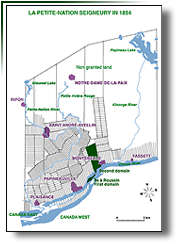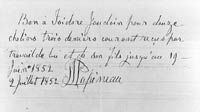The seigneury of La Petite-Nation
Manoir Papineau National Historic Site
The Seigneurial System
Seigneurial tenure was a legal and economic system of landholding which originated in France and which was introduced in New France as a basis of settlement. The seigneury was an estate, or fief, which the king granted to a lord (or seigneur in French), who was in charge of settling colonists (called censitaires ) on parcels of land. For his trouble, the seigneur was paid rent and dues, and enjoyed a number of honorific rights as well. Farming was the mainspring of the seigneurial economy. Between 1624 and 1760, 250 seigneuries were ceded, 200 of which were located along both shores of the St. Lawrence River and its main tributaries.
Map of the Seigneuries in New France, 1624-1760, also accessible in PDF format (62 kb) . This map indicates the location of La Petite-Nation seigneury in relation to the other seigneuries.
La Petite-Nation
François de Laval, bishop of Petrea and vicar apostolic of New France, became seigneur of La Petite-Nation on May 16, 1674. This 25-league fief (5 leagues along the Ottawa River shore by 5 leagues inland) was named after the Algonquin tribe called the Petite Nation and which had previously inhabited the area.
This mountainous, forested area covering close to 635 km2 had little arable land. For more than 50 years, only a single grant of land had been made. Afterwards, the Crown prohibited any settlement, as markets and defence posts were too far distant. In addition, the authorities did not want to jeopardize the Ottawa Valley fur trade.
Seigneur Papineau
 Map of the seigneury of La Petite-Nation in 1854
Map of the seigneury of La Petite-Nation in 1854©Parks Canada, 1854
In 1803, Joseph Papineau, a notary and politician, became the new seigneur of La Petite-Nation. He built a manor house on his domain on Roussin Island and began settling the first censitaires. In 1817, he sold the seigneury to his oldest son, Louis-Joseph. Denis-Benjamin, the brother of Louis-Joseph, was in charge of managing the lands, which were then inhabited by 300 people.
After returning from exile, Louis-Joseph Papineau set up permanent residence in the seigneury and began work building the manor house he was to complete in 1850. By that time, the seigneury numbered 3289 inhabitants, who occupied approximately 30% of the total surface area.
 Seigneur's
coupon, July 2, 1852
Seigneur's
coupon, July 2, 1852© Parks Canada / Fonds Renée Papineau Christie / 1852
Upon Louis-Joseph Papineau's death in 1871, the seigneury was split among the descendants. The portion bequeathed to Louis-Joseph-Amédée Papineau went by the name of the "Papineau seigneury" whereas the portion left to the children of the late Azélie Papineau and Napoléon Bourassa went by the name of "La Petite-Nation seigneury proper."
The seigneurial system of land tenure was officially abolished in 1854.
Related links
- Date modified :